This is Part 1 of a two-part series of painting portraits tips written by my good friend and fellow artist, David Goatley.
Years ago, I met David at one of his portrait painting workshops. Not only does David epitomize the ‘true English gentleman’ but I was so impressed with David’s capabilities that I commissioned him to paint my three children.
First, a bit about your instructor:
David Goatley is widely recognized as one of the NW leading portrait painters. Formally trained at Camberwell School of Art in London, England 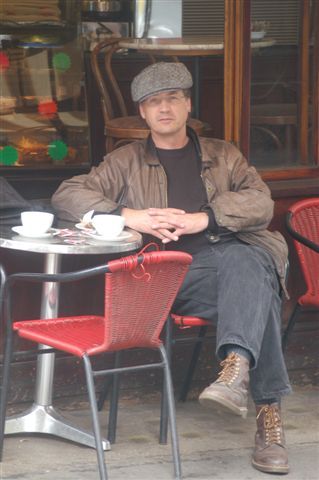 where he was born, David has completed well over 200 portrait commissions all across n America since arriving here in 1992. In the USA, David has painted many leading business figures and their families, working in 19 states so far. His sitters are notable including, artist Robert Bateman, Prime Minister Kim Campbell of Canada and other official parliamentary portraits.
where he was born, David has completed well over 200 portrait commissions all across n America since arriving here in 1992. In the USA, David has painted many leading business figures and their families, working in 19 states so far. His sitters are notable including, artist Robert Bateman, Prime Minister Kim Campbell of Canada and other official parliamentary portraits.
Painting Portraits 101: Part 1 – Proportions
by guest artist/author David Goatley
Painting portraits is not easy. Portraits carry a great level of expectation from their sitters and a whole lot of psychological baggage as well. Nobody wants a portrait that is ‘a bit like them’ they want it to be a true likeness, so the artist has to be accurate in a way that few other painting disciplines require. For instance, no one cares if you move a tree in a landscape, as long as it helps your painting. Artists themselves want to capture the inner person as well as the outer appearance, if they can, so hopes are high!
Are there any general principles that make this complex business easier?
First, I think it helps to remember a few tipsat the outset:
- The sitter, whilst a strong and distinct personality, is just a three dimensional object in space.
- Like any object, the sitter has light falling on him or her.
- Get a sense of that ‘object’ and the way light and shadow plays on ‘it’ first, then you will have a strong foundation to build on for the particular details that make your subject unique.
- If you find yourself worrying about the inner workings of your sitter’s mind before you have the big lights and darks working for you – you’re in trouble.
The following are some universal rules to help you…
Proportions:
- A person’s eyes are always half way up his or her head.
- The eyebrow is above the half way point of the head, on a person with a ‘normal’ hairline (not one like mine , which goes all the way to the top of my head these days!)
- The only exeception to the above rule is with a very young child – the child’s head is larger and the features are lower.
- The distance from the hairline to the eyebrow, the eyebrow to the underside of the nose and from the underside of the nose to the chin are almost exactly the same – splitting the dimensions of the face into thirds. This is handy to know if you are worried you may have got the nose a little too long, or the nose to chin distance – you can check one against the other. Variations in this are tiny.
- In a younger adult the tops of ears are usually roughly in line with the eyebrow,
the lobe with the bottom of the nose. - As people age their ears get larger and the lobes head south.
- When the sitter looks straight at you, the corners of his or her mouth are usually line up vertically with his or her pupils. Variations to this rule are small.
- The tear duct is vertically aligned with the outer edge of the nose.
- There is always exactly room for a third-eye between the two you have!
- The underside of the bottom lip usually falls halfway between the underside of the nose and the chin.
- In a three quarter profile these alignments still work, except that now you will see a quarter of the width of the mouth, one side of an imaginary centre line and three quarters of its width the other.
- The corner of the eye furthest from you will now be hidden by the bridge of the nose, but its centre will still line up with the corner of the mouth.
- Remember, an iris that is round looking straight at you will become slightly elliptical as it is turned away from you.
- In a profile the distance from the corner of the eye to the jawline and from the corner of the eye to the back of the ear is usually the same.
- You can also use the head as a measuring tool for the rest of the figure in a full body portrait.
- Humans are generally between six and seven heads tall. (at 6′ 1″ I am seven heads plus an inch tall)
- Two head lengths below the chin you’ll hit the belly button.
- Another head below then you’ll be at the crotch.
- Another head beyond that takes you to mid thigh and so on.
If in doubt, always refer back to the above simple rules to check your drawing! Be sure and read Painting Portraits Part 2 – Start to Finish.
David Goatley,
www.davidgoatley.com




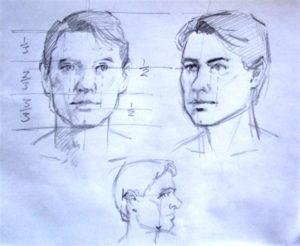


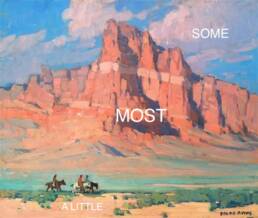
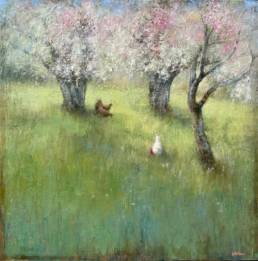
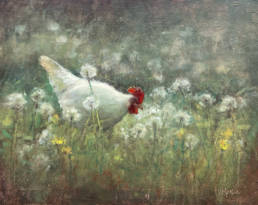
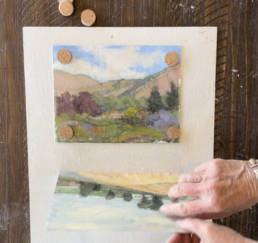
I enjoyed the post on Portrait Proportions by your guest author David Goatley.
His work is fantastic, what a treat he was to discover!
He explained the subject matter in a very clear and direct way. Very useful. I’ve been thinking of trying some portraits again lately and this article will be a good place to start from!!
Your whole blog is full of stuff,I can’t wait to read!!
Thanks,
Joan
well.. it’s like I knew!
Thanks for this article! I need to get more practice with portraits. This will be a good set of tips to keep handy.
I paint with two groups weekly. I have not done portraits yet but your instructions give me hope that I might be able to do a decent attempt at it. We’ll see.
Yay Jean! It makes me so happy to hear this post has helped you. Please let me know how it goes…. 🙂